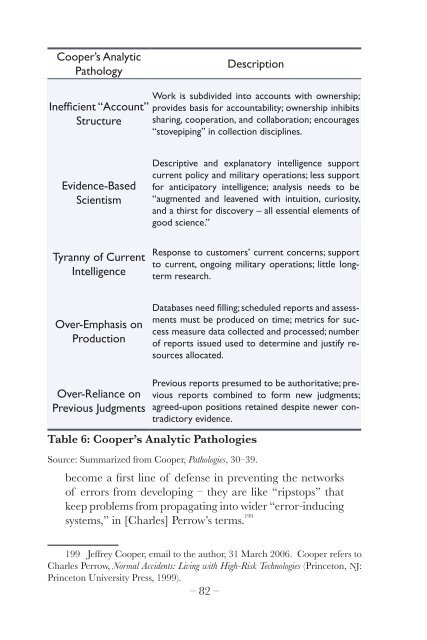Critical Thinking and Intelligence Analysis
Critical Thinking and Intelligence Analysis
Critical Thinking and Intelligence Analysis
Create successful ePaper yourself
Turn your PDF publications into a flip-book with our unique Google optimized e-Paper software.
Cooper’s Analytic<br />
Pathology<br />
Description<br />
Inefficient “Account”<br />
Structure<br />
Work is subdivided into accounts with ownership;<br />
provides basis for accountability; ownership inhibits<br />
sharing, cooperation, <strong>and</strong> collaboration; encourages<br />
“stovepiping” in collection disciplines.<br />
Evidence-Based<br />
Scientism<br />
Tyranny of Current<br />
<strong>Intelligence</strong><br />
Descriptive <strong>and</strong> explanatory intelligence support<br />
current policy <strong>and</strong> military operations; less support<br />
for anticipatory intelligence; analysis needs to be<br />
“augmented <strong>and</strong> leavened with intuition, curiosity,<br />
<strong>and</strong> a thirst for discovery – all essential elements of<br />
good science.”<br />
Response to customers’ current concerns; support<br />
to current, ongoing military operations; little longterm<br />
research.<br />
Over-Emphasis on<br />
Production<br />
Databases need filling; scheduled reports <strong>and</strong> assessments<br />
must be produced on time; metrics for success<br />
measure data collected <strong>and</strong> processed; number<br />
of reports issued used to determine <strong>and</strong> justify resources<br />
allocated.<br />
Over-Reliance on<br />
Previous Judgments<br />
Previous reports presumed to be authoritative; previous<br />
reports combined to form new judgments;<br />
agreed-upon positions retained despite newer contradictory<br />
evidence.<br />
Table 6: Cooper’s Analytic Pathologies<br />
Source: Summarized from Cooper, Pathologies, 30–39.<br />
become a first line of defense in preventing the networks<br />
of errors from developing – they are like “ripstops” that<br />
keep problems from propagating into wider “error-inducing<br />
systems,” in [Charles] Perrow’s terms. 199<br />
199 Jeffrey Cooper, email to the author, 31 March 2006. Cooper refers to<br />
Charles Perrow, Normal Accidents: Living with High-Risk Technologies (Princeton, NJ:<br />
Princeton University Press, 1999).<br />
– 82 –
















